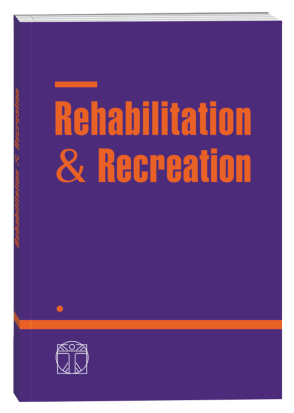ІНТЕНСИФІКОВАНА ПРОГРАМА ФІЗИЧНОЇ РЕАБІЛІТАЦІЇ ХВОРИХ НА ІНФАРКТ МІОКАРДА В УМОВАХ СТАЦІОНАРУ
Ключові слова:
інфаркт міокарда, фізична реабілітація, стаціонарний етапАнотація
Мета: розробка та наукове обґрунтування комплексної програми фізичної реабілітації для хворих на інфаркт міокарда, яка передбачає ранню активізацію рухового режиму. Методи: використовували клінічні та параклінічні методи з підрахунком частоти серцевих скорочень та вимірюванням артеріального тиску у стані спокою і після функціональних проб для розрахунку индексу Робінсона, у т.ч. після переходу з положення лежачи в положення стоячи (ортостатична проба). Застосовували руховий тест без зорового контролю фізичного зусилля. Після тесту оцінювалося відхилення від заданого темпу (тобто – почуття часу) та загальна реакція хворих на фізичне навантаження. Результати. Відповідно до стаціонарних режимів рухової активності апробовані функціональні проби з фізичним навантаженням, які виявились придатними для оцінки функціонального стану серцево-судинної системи та рухових можливостей пацієнтів. При суворому ліжковому режимі це активний поворот на правий бік, розширеному ліжковому режимі – сидіння у ліжку 5 хв, палатному режимі – стояння біля ліжка 5 хв та ортостатична проба, вільному руховому режимі – 5 вставань зі стільця протягом 10 с без зорового контролю фізичного зусилля. Висновки. Обґрунтована і розроблена комплексна програма фізичної реабілітації в умовах стаціонару для хворих чоловіків 40-65 років на інфаркт міокарда різного функціонального класу тяжкості, що включала лікувальну фізичну культуру, масаж, дозовану ходьбу, ходьбу по сходинках та дієту. Вона відрізнялась прискореними термінами призначення лікувальної гімнастики і переводу хворих на розширені рухові режими в залежності від тяжкості інфаркту міокарда. Для хворих з дрібновогнищевим та великовогнищевим неускладненим інфарктом міокарда (І-ІІ клас тяжкості) програма фізичної реабілітації розрахована на 4 тижні, а для хворих з великовогнищевим ускладненим інфарктом (ІІІ клас) – в середньому на 6 тижнів. При оцінюванні ефективності розробленої програми за типами реакції на дозовані фізичні навантаження виявлено їх достовірне покращення, а також поліпшилась нервова регуляція серцево-судинної системи за даними ортостатичної проби. Відбулися позитивні зміни загального стану, зникли запаморочення та слабкість. Отримані результати можна рекомендувати до впровадження.
Посилання
АроновД.М., Лупанов В.П. Функциональные пробы в кардиологии. М.: МЕДпресс-информ, 2002. 296 с.
БубноваМ.Г., Аронов Д.М. Клинические эффекты годичной программы кардиореабилитации с применением физических тренировок после острого инфаркта миокарда у больных трудо-способного возраста с разным реабили-тационным потенциалом. Кардиоваскулярная терапия и профилактика, 2019. №5. С. 27-37.
Бубнова М.Г. Клиническое 16-летнеенаблюдение за больными, перенесшими острый инфаркт миокарда: феномен высокой приверженности к физической реабилитации. Вестник восстановительной медицины. 2016. № 4. С. 12-19.
ВОЗ.Всемирный атлас по профилактике и контролю сердечно-сосудистых заболеваний. Женева; 2010. 108 с.
Галявич А.С., Балеева Л.В., ГалееваЗ.М., Галимзянова Л.А. Вазоспастическая стенокардия – вазоспастический инфаркт миокарда. Российский кардиологический журнал. 2020;25(2):98-99
Кириллов В.В. Научно-техническийпрогресс в системе догоспитальной диагностики и лечения пациентов с острым коронарным синдромом. Доктор РУ. 2018. № 4. С. 59-65. 7.Некоркина О.А. Лечебная физкультурав статико-динамическом режиме при остром инфаркте миокарда. Автореф. дисс… канд. мед. наук. М., 2002. 18 с. 8.Обзор обновленных рекомендацийАмериканской ассоциации сердца по сердечно-легочной реанимации и неотложной помощи при сердечно-сосудистых заболеваниях от 2015 г. Врач скорой помощи. 2017; 2: 9–29; 3: 4–41. 9.Округин С.А., Кужелева Е.А.,Гарганеева А.А. Программа ВОЗ «Регистр острого инфаркта миокарда»: эпидемиологический мониторинг острых коронарных катастроф. Комплексные проблемы сердечно-сосудистых заболеваний, 2018;7(1):76-83.
Поллок М.Л., Шмідт Д.Х.Захворювання серця і реабілітація. Київ: Олімпійська література, 2000. 408 с.
Стентон Гланц. Медико-биологическаястатистика; пер. с англ. М.: Практика, 1999. 459 с.
Ruff C.T., Braunwald E. The evolvingepidemiology of acute coronary syndromes. Nat. Rev. Cardiol. 2011; 8(3): 140–7.
Chan P.S., McNally B., NallamothuB.K., Tang F., Hammill B.G., Spertus J. A. et al. Long-term outcomes among elderly survivors of out-of-hospital cardiac arrest. J. Am. Heart Assoc. 2016; 5(3): e002924.
Priori S.G., Blomström-Lundqvist C.,Mazzanti A., Blom N., Borggrefe M., Camm J. et al. ESC Guidelines for the management of patients with ventricular arrhythmias and the prevention of sudden cardiac death: The Task Force for the Management of Patients with Ventricular Arrhythmias and the Prevention of Sudden Cardiac Death of the European Society of Cardiology (ESC). Endorsed by: Association for European Paediatric and Congenital Cardiology (AEPC). Eur. Heart J. 2015; 36(41): 2793–867.
Monsieurs K.G., Nolan J.P., BossaertL.L., Greif R., Maconochie I.K., Nikolaou N.I. et al. European Resuscitation Council Guidelines for Resuscitation 2015: Section 1.
Executive summary. Resuscitation. 2015; 95: 1–80.
Pedersen C.T., Kay G.N., Katman J.,Borggrefe M., Della-Bella P., Dickfeld T. et al. EHRA/HRS/APHRS expert consensus on ventricular arrhythmias. Europace. 2014; 16(9): 1257–83.
##submission.downloads##
Опубліковано
Як цитувати
Номер
Розділ
Ліцензія

Ця робота ліцензується відповідно до Creative Commons Attribution-NonCommercial-NoDerivatives 4.0 International License.












